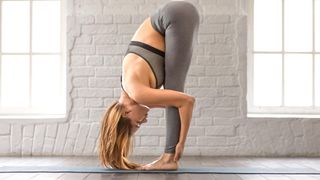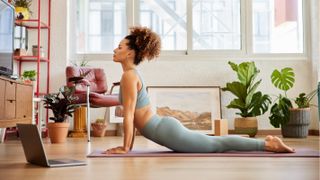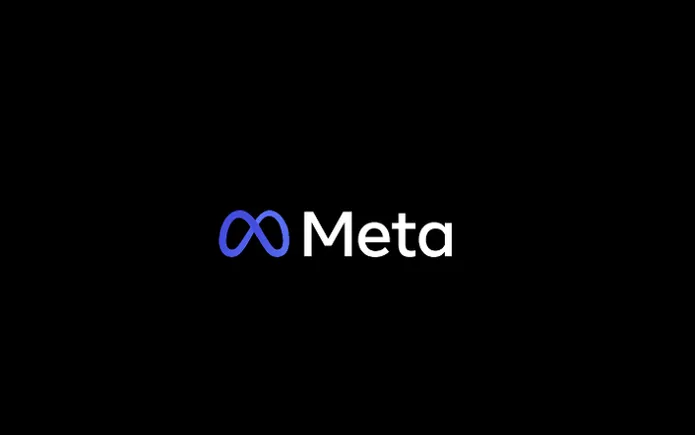If you've been looking at all the different types of yoga, but feel like what you're really after is a calming practice where you roll out your yoga mat and hold seated poses designed to offer a deep, relaxing stretch, then you need Yin Yoga.
It's a calmer, less dynamic form of the practice, making it ideal for when you want to boost your awareness of your body, relieve tension in your muscles, and boost your flexibility.
And although holding poses for up to 20 minutes at a time can sound daunting, Yin is an accessible route into yoga, especially if you're not a fan of the more dynamic classes often found on the best yoga apps.
To help you get started, we spoke to an expert trainer about what Yin yoga really is, whether you need anything for your practice and all the physical and mental benefits this more relaxed form of yoga can bring.
What is yin yoga?
Yin yoga is a style of yoga that involves holding various seated and reclined poses for a longer period of time to help you stretch deeper whilst quieting the mind. The poses are mainly seated, with no sign of planks, dynamic Sun Salutations, or Warriors.
It was made popular in the 1980s by Paul Grilley, and typically features poses held for anywhere between three and twenty minutes each. The pace is nourishing for both the body and mind and is designed to slowly release the joints of the body while finding stillness in each posture.
"Yin yoga is all about feeling your movements and taking it slow, making it different from stretch-based exercises such as regular yoga and Pilates, which tend to be more dynamic,” explains Personal Trainer Alasdair Nicoll, from The Fitness Group.
“The practice is ideal for those looking for a more mindful approach to movement and is incredibly beneficial for [those] seeking stress relief.” The postures aren’t what you’d expect from a usual yoga class, even if they do look similar.
The idea is to not have your muscles engaged as you hold each pose for longer periods of time which allows your body to stretch and lengthen, whilst using your deep breaths to each into each pose and focus on the present moment
The practice is all about working with your own body, rather than getting into the ‘perfect’ position and trying to look like everyone else; it’s your body, your practice with more than enough time to find stillness in each pose as you melt deeper into each move.
Mental benefits of yin yoga

“Yin yoga promotes mindfulness and a meditative state, which makes it particularly effective for reducing stress and calming the nervous system, unlike other more intense exercises which require you to pay more attention,” says Nicoll.
Holding each pose and focusing on deep breathing can also help with grounding, calming and revitalising your emotional state. The hope is that with each class you develop more mindfulness and ability to look inwards and sit with any emotions and irritations that arise, as we work through postures.
Because of this, yin can be amazing for helping you to deal with any frustrations and discomforts which can then be utilised not only on the mat, but also in everyday life. As you hold each pose you’ll find that your mind plays tricks on you and forces you to focus on your breath.
The trick is to breathe, relax and let go. “Whereas other stretching-based exercises focus on the mind/body connection, yin aims to separate the two as a form of moving meditation. Thanks to its slower pace and inward connection the meditative practice is also a great sleep helping many prepare themselves for bed,” adds Nicoll.
Physical benefits of yin yoga
Despite being a simple, quiet practice, don’t be fooled — yin isn’t as easy as it sounds. First and foremost, it’s not supposed to be comfortable; it will take you well outside your comfort zone as each pose is held for so much longer than normal.
Rather than 30 seconds per pose, you’re instead looking at 3-20 minutes which takes you to a whole new zone of discomfort, allowing the deeper, less flexible tissues in your body the time to stretch and you to manage your breathing you as breathe through the discomfort and ease into each stretch.
Yin works into the fascia in the body, also known as connective tissue — the tissue that pretty much holds us together in one piece, connecting bones, muscles and everything in between.
“If your fascia is stuck, you can stretch your muscle as much as you like but your flexibility may not change all that much,” explains Nicoll. “This is why yin is so effective — it slowly opens the fascia to give your muscles more space to move and elongate, all without over-stressing the muscles.”
Other benefits include improved flexibility and joint mobility that will see you progress in all other aspects of yoga practices as well as other sports like running, cycling and swimming which all shorten the muscles and can make your body less efficient and tight.
“This slow and deep approach also improves joint mobility and flexibility, especially in areas like the hips, spine, and lower back which by itself will make you more physically capable and better able to recover from things such as falls which normally might cause you injury,” says Nicoll.
“Your posture will improve too thanks to your increased range of motion and body awareness and the extra breathing means that more oxygen is pumped freely around your body, boosting blood flow and circulation.”
Is yin yoga good for beginners?
Yin yoga is great for beginners because the poses are physically straightforward. “This method of yoga is significantly more accessible than some of the more athletic workouts because you’re feeling your movements and taking it slow,” Nicol says.
“For those with stiff muscles or a limited range of motion, yin can complement more dynamic exercises by encouraging flexibility without over-stressing the muscles. Plus, it’s easily accessible and the modifications make it open to nearly anyone.”
3 yin yoga poses to try
At first glance, yin yoga poses look simple, but when you hold them for three minutes or more, you’ll see how deeply they challenge your flexibility and mental strength.
And since it’s more of a passive practice, you won’t be shaking and sweating as much as you would be in other styles of yoga or stretching classes. So, if you're ready to give the practice a try, we've listed three poses to explore.
After each one, be sure to come out of the pose slowly and enjoy the ‘rebound’, where you’ll lay down on the floor and just notice the sensations in the body. Sit with them for a minute or so before moving on to the next pose.
1. The dangle
Dangle Pose - Yin Yoga Pose Breakdown with Dr. Truth Robinson and LIVING YIN - YouTube

Hold: 3 minutes
The dangle is one of two yin yoga standing poses and aims to gently stretch the lower spine, loosen the hamstrings and warm up the quadriceps whilst building strength in the diaphragm and providing a massage for the abdominal organs.
- Stand up with your feet hip-width apart, bend your knees and fold forward. Clasp the elbows with the opposite hands.
- Hang here for three minutes before bending your knees, releasing your hands to the floor and slowly rolling up. This is sometimes called Rag Doll.
2. The butterfly pose
How to do Butterfly Pose - Badhakonasana - YouTube

Hold: 3-5 minutes
Also known as Baddha Konasana, the butterfly pose is an accessible, beginner-friendly yin yoga pose which will stretch the lower back without requiring loose hamstrings.
- Begin in a seated position with the soles of your feet pressed together. Hinge forward at your hips.
- Let your spine relax and round as you press your forehead toward your feet, allowing gravity to pull your upper body down.
- Hold. If you’d like to make this pose more comfortable add some yoga blocks under each knee or underneath your forehead for extra support.
3. The swan pose
Swan Pose explained, Yoga with Olav Aarts - YouTube

Hold: 3 minutes on each side
The swan pose is quite similar to pigeon pose, and an elegant yet relaxing way to gently open the hips and either stretch the back if you fold forward or compress it when you're upright.
- From a kneeling position, or downward dog, slide your left knee forward, placing it behind your left wrist. Make sure your left ankle is positioned in front of your right hip and flex your left foot.
- Slide your right leg straight out behind you.
- Keep your weight centred between your hips, then gently slide your arms forward as you let gravity pull your upper body down. You should feel a gentle sensation in your hips as you stretch forward.
More from Tom's Guide
- 6 tips for trying yoga for beginners — from a yoga instructor
- A yoga teacher says this 10-minute flow can help relieve back pain, so I tried it — here's what happened
- I tried a calming mindful yoga practice, and the results were surprising





















 English (US) ·
English (US) ·